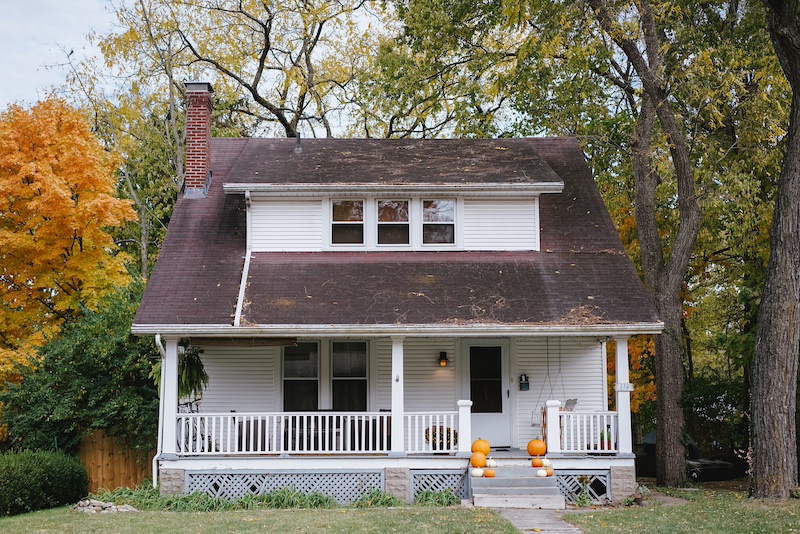Roof Replacement: The Ultimate Guide for Homeowners
It might be time to up your roof game.

It might be time to up your roof game.

Shopping for a new roof isn’t cheap or especially fun, but it’s essential for maintaining a healthy home–and keeping your insurance premium down.
In fact, a roof’s age is one of a home’s biggest risk factors. In addition to threatening your property’s structural integrity, an old roof is generally much harder to insure.
While a typical homeowners policy will protect your roof from a variety of named perils, like hailstorms, water damage, fallen branches, etc., most insurance providers will generally not cover homes with roofs that are more than 20 years old.
In this guide, we’ll tell you everything you need to know about replacing the roof over your head.
It might seem obvious, but your roof is pretty important. It’s not only one of the first impressions your house makes to the outside world but one of the first parts to be impacted by severe weather or natural disasters.
Although roof replacements generally aren’t covered by your homeowners policy— which won’t cover damages resulting from general wear and tear— a new roof will offer you more insurance protection in the event that a bad thing happens, and it can mean the difference between staying covered and struggling to find an insurance policy.
Keeping your roof up to date will show your insurer that you’re lower risk by demonstrating that you’ve been on top of your home maintenance checklist. If your roof were past its expected lifespan, most insurers wouldn’t renew an existing homeowners insurance policy, and you’d have a hard time securing coverage with a new insurer.
On the flip side, because it counts as a home improvement, a new roof could even lower your premium.
But good roof maintenance doesn’t end with a replacement; you should still make sure your roof is free of any signs of wear and tear. As a rule of thumb, it’s a good idea to have a professional inspect your roof twice a year and immediately after any big weather event.

A lot can happen to a roof. Knowing what kind of damage to look for and how to identify it will help you decide if and when it’s time for a replacement.
Weather is perhaps your roof’s biggest enemy. Wind, ice, and UV rays are especially threatening to its structural integrity. These effects can either strike all at once–in the case of, say, a big hail storm–or wear away at your roof slowly. UV exposure, for instance, accumulates over time, gradually breaking down the molecules in your shingles and eventually causing them to crack.
But big weather events and constant exposure to the elements are not the only things that can damage your roof. Common causes of wear and tear include overgrown trees, buildups of debris, and the presence of pests like rodents, termites, and birds. These threats are inevitable, no matter where you live, which is why you should replace your roof every 20 years or so.
When looking for evidence of damage, it’s important to examine your roof from multiple vantage points.
Here’s a checklist of everywhere you can safely check your roof without getting up there (for that, we recommend a roofer or gutter company):
Replacing your roof is a significant investment, and finding the right roofer is crucial to getting the job done correctly, efficiently, and within your budget.
Here are some tips to help guide your research during the process of selecting a reputable roofer and what to look for in a contract.
Begin by searching for roofers in your local area. Choosing a nearby roofer makes scheduling much simpler, especially if additional work is required after the initial job is done. You’ll have peace of mind knowing your roofer is just a short drive away, ready to meet your needs.
Start by asking friends, family, or neighbors if they can recommend a good roofer. Online reviews and ratings on sites like Yelp or Google can also provide insight into the quality of a roofer’s work.
When selecting a roofer, it’s important to check for the right licenses and insurance. Licensing and insurance requirements vary by state, and not all states mandate licensing or insurance for roofing contractors. For a state-by-state breakdown, you can refer to Fixr.
Here are some licenses and insurance to look for:
Please note, that while your state may not require the above licensing or insurance, you may want to select a roofer who does have some of the above credentials. By doing so, you will be better protected against unknowns.
It’s vital to verify a roofer’s credentials and certifications from reputable manufacturers or industry organizations.
Here are a few certifications you can look for:
By making sure your roofer has one or more of these certifications, you can be confident in their expertise and the quality of their work.
Ask to see a portfolio of past projects, or even see if you can visit completed job sites to get a sense of their workmanship. A reputable roofer will be proud to showcase their previous work and provide references from satisfied customers.
Don’t settle for the first estimate you receive. Getting at least three quotes will give you a better understanding of the going rate and help you spot any outliers. Be wary of quotes that seem too good to be true—they often are.
When reviewing your roofing contract, there are several key elements you need to review to make sure that everything is clearly defined. Having an understanding of the contract you are entering into, will help to avoid confusion or miscommunication during the course of construction. Here’s what to look for:
There’s no way around it—the costs of a new roof can be overwhelmingly expensive. A roof replacement could set you back anywhere from $6,700 to $80,000, depending on where you live, how big your house is, and what kind of roof you’re installing.
Still, there are several ways to soften the blow to your wallet. Let’s break them down.
Here are some common options for roof financing:
Before committing to any of these financing options, make sure to shop around for the lowest interest rates and the most reputable contractors.
Some plans, like home equity loans and cash-out refinances, will also require you to get a home appraisal as part of your application. And, if you aren’t fast approaching your roof’s expected lifespan, it may be worth building up your credit and then replacing your roof.

In addition to making a financial plan, you’ll need to decide what kind of roof you want. Maybe you’re drawn to classic asphalt shingles, or perhaps you’re ready to spring for a stunning slate roof that will stand the test of time.
A new roof is hardly a casual purchase, so it’s important to know what’s out there. We’ve compiled a list of some common roofing materials to consider.
Here are some of the most popular kinds:
When you’re deciding on a roof type, you should also take your homeowners policy into consideration.
Because they’re so durable, slate and metal roofs tend to yield lower premiums. Meanwhile, wooden roofs generally aren’t insurable because they’re not fire-resistant.
Once you’ve decided to replace your roof, you’ll need to do some planning to schedule your replacement for a convenient time.
Roofing companies are often booked up for weeks in advance, especially during busy seasons like the fall.
You should plan your replacement around the season and climate–moderate temperatures are generally ideal for roof installments. For this reason, fall is usually peak roofing season; however, spring is a good (and lower-demand) alternative if you can avoid extreme weather.
If you’re looking to replace your roof during the summer or winter, beware of how extreme temperatures can affect roofing materials. Asphalt shingles, for example, are difficult to install in high temperatures, while cold temperatures can sometimes prevent roof sealants from setting.
And, as soon as you’ve got your new roof, make sure to update your insurance company with proof of installation. It just might save you some money!
A few quick words, because we <3 our lawyers: This post is general in nature, and any statement in it doesn’t alter the terms, conditions, exclusions, or limitations of the policies issued, which differ according to your state of residence. You’re encouraged to discuss your specific circumstances with your own professional advisors. The purpose of this post is merely to provide you with info and insights you can use to make such discussions more productive! Naturally, all comments by, or references to, third parties represent their own views, and Lemonade assumes no responsibility for them. Coverage may not be available in all states. Please note that statements about coverages, policy management, claims processes, Giveback, and customer support apply to policies underwritten by Lemonade Insurance Company or Metromile Insurance Company, a Lemonade company, sold by Lemonade Insurance Agency, LLC. The statements do not apply to policies underwritten by other carriers.
Please note: Lemonade articles and other editorial content are meant for educational purposes only, and should not be relied upon instead of professional legal, insurance or financial advice. The content of these educational articles does not alter the terms, conditions, exclusions, or limitations of policies issued by Lemonade, which differ according to your state of residence. While we regularly review previously published content to ensure it is accurate and up-to-date, there may be instances in which legal conditions or policy details have changed since publication. Any hypothetical examples used in Lemonade editorial content are purely expositional. Hypothetical examples do not alter or bind Lemonade to any application of your insurance policy to the particular facts and circumstances of any actual claim.